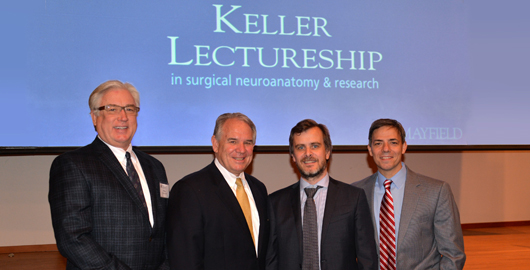
The bottom part of the brain – the area from your ears and nose to the base of your skull – is a labyrinth of passageways, cranial nerves, and arteries. Few understand this remote and complex territory better than Sébastien Froelich, MD, Professor and Chairman of Neurosurgery at Lariboisière Hospital in Paris.
Dr. Froelich explored the balance between surgical accomplishment in the skull base and patient welfare Wednesday while speaking as the 2017 Keller Lecturer in Surgical Neuroanatomy & Research on the University of Cincinnati Academic Health Center campus. At the heart of that balance is the surgeon’s weighing of risk and perhaps status: whether to approach the tumor through the skull in a transcranial procedure, or whether to approach through the nose with a newer endoscopic technique.
“Endoscopic technique is great if it enables you to serve the treatment of pathology,” he said. “But some patients have paid the price for our trying to push technique forward.”
The Keller Lectureship, an endowment at the Mayfield Education & Research Foundation, is named for Jeffrey T. Keller, PhD, Research Professor of Neurosurgery & Anatomy and Cell Biology at UC and the Mayfield Clinic. Dr. Froelich trained at the Mayfield-UC Department of Neurosurgery as a research fellow under Dr. Keller from 1999 to 2000 and returned later as a skull base clinical fellow from 2005 to 2006.
Dr. Froelich lecture, Part 1 >
Dr. Froelich lecture, Part 2 >
Lee Zimmer, MD, PhD, lecture >
Norberto Andaluz, MD, a Mayfield neurosurgeon and skull base specialist, recalled meeting Dr. Froelich 17 years ago, when Dr. Froelich was “in the lab working harder than anyone else, working to develop new ideas.”
Since that time neurosurgeons and ENT surgeons have forged ahead with ever-more-sophisticated endoscopic endonasal approaches to the skull base. Rather than approaching tumors through a (transcranial) opening in the skull, they established revolutionary new techniques that involved approaching tumors through the nose. The approach was made possible by an intimate understanding of skull base anatomy along with elegant and refined endoscopic instrumentation.
“You need to spend many hours in the lab to understand what you are seeing,” Dr. Froelich said. “The anatomy is unchanging, but it looks different depending on where you look at it from.”
Discovering the intricacies and variations in skull base anatomy “should be accomplished in the lab, not during surgery,” he said. This involves long hours spent learning to understand the relationships between arteries and cranial nerves, even when a structure cannot be physically seen. It also involves careful assessments of preoperative imaging.
“If you hit the carotid artery because of an anatomical variant in its trajectory — something that could have been seen before on a CT angiography scan — it is not forgivable,” he said.
Dr. Froelich stressed conservatism and awareness of the very real risks to the patient from cerebrospinal fluid (CSF) leaks, which can lead to meningitis. Tumors that are infiltrative, hard, or calcified present added risks, as do tumors that have recurred following an earlier surgery that has altered the landscape. When approaching a schwannoma tumor through the nose, Dr. Froelich said, he was prepared to abandon the procedure if the tumor did not have a soft consistency and could not be suctioned out.
“We must look at real morbidity,” Dr. Froelich said. “There are times when an endoscopic approach is debatable. We should not attempt a surgical challenge for personal achievement — a technique that may be a challenge for the surgeon but is not good for the patient. We have to be careful. We can’t increase morbidity when we have technologies we think might help.”
In some cases one surgical approach is not sufficient to extract the bulk of a tumor. “You may have to choose which part of the tumor you’re able to remove; in some cases you may need two approaches to get more of the tumor.”
Armed with flexibility and dexterity, the result of imagination and years of practice, Dr. Froelich at times wields three instruments in his hands simultaneously. He has used the endoscope not only in endonasal procedures, but in transcranial procedures as well.
When removing an entire tumor is impossible, Dr. Froelich relies on his radiation oncology colleagues to target remaining fragments.
Dr. Froelich said he has stopped removing meningioma tumors with an endoscope through the nose because of the high risk of CSF leaks. “The advantage of an endoscopic endonasal approach for some meningiomas is that you reach the base of the tumor first and avoid brain retraction,” he said. “But even if it works, I’m not sure it is a good choice if there’s CSF leak.”
A new frontier – and art form — for Dr. Froelich involves closing incisions during endoscopic cases with stitches. “We are trying to close with stiches as much as possible,” he said. “When you start it takes 45 minutes for 3 stitches. But the time spent is worthwhile for the patient by eliminating the risk of a CSF leak and subsequent mortality.”
* * * * *
The Keller Lectureship was established with generous donations
from Mayfield Society colleagues and friends of the Mayfield Clinic.
To make a financial donation to the Keller Lectureship Fund,
please contact Deborah Livingston, Development Director, at (513) 569-5277 or dlivingston@mayfieldfoundation.org.
Or visit https://www.mayfieldfoundation.org/donatenow
— Cindy Starr